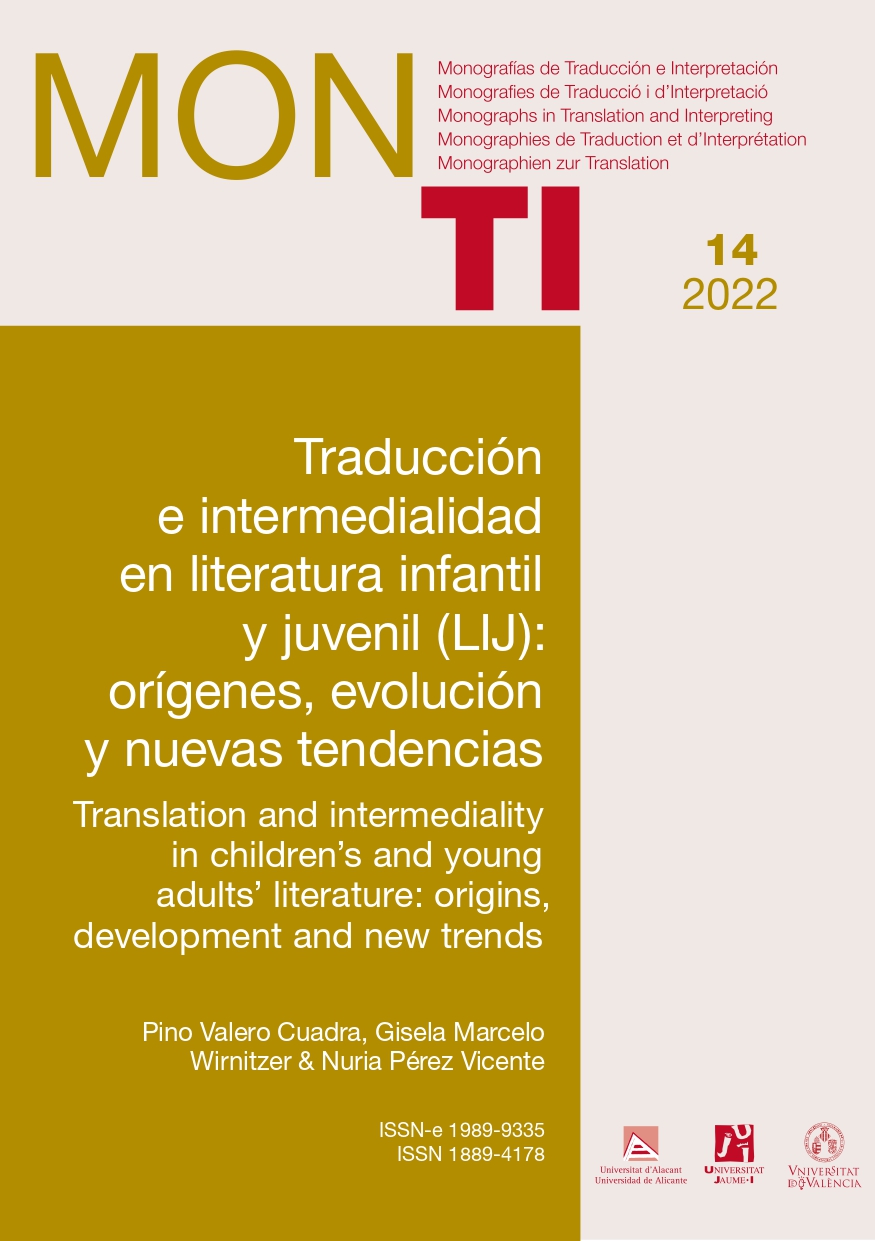Lectura en voz alta y lenguajes inventados: traducir Du iz tak?, de Carson Ellis
##plugins.themes.bootstrap3.article.main##
Resum
El presente artículo estudia la traducción de la obra Du Iz Tak?, de Carson Ellis, en España y Francia. Du Iz Tak?, que ganó el premio E. B. White al libro que mejor se prestaba a ser leído en voz alta, se caracteriza por estar escrito en una lengua inventada, la lengua de los insectos. El propósito en las páginas que siguen es estudiar los mecanismos que llevan a la traducción de esta obra de Ellis y analizar cómo Koi ke bzzz? y ¿Mau iz io? suponen dos modos de abordar la traducción de los lenguajes inventados y de considerar la lecturabilidad.
Descàrregues
##plugins.themes.bootstrap3.article.details##
La propietat intel·lectual dels articles pertany als autors i els drets d'edició i publicació, a la revista. Els articles publicats en la revista podran ser utilitzats lliurement per a propòsits educatius i científics, sempre que se'n faça una correcta citació. Qualsevol ús comercial és expressament penat per la llei.
Referències
Fuentes primarias
ELLIS, Carson. (2017a) Du Iz Tak? London: Walker Books.
ELLIS, Carson. (2016) Koi ke bzzz? Traducción de Sophie Gi-raud. Paris: Hélium.
ELLIS, Carson (2017b). ¿Mau iz io? [Sin indicación autoría traducción]. Albolote, Granada: Barbara Fiore.
Fuentes secundarias
AMERICAN BOOKSELLERS ASSOCIATION (s.a.). E. B. White Read Aloud Information and FAQs. Versión electrónica: <https://www.Bookweb.Org/Membership/ABC/EBWhitefaqs.>
CÁMARA AGUILERA, Elvira (2009). “The translation of proper names in children’s literature.” Anuario de Investigación en Literatura Infantil y Juvenil 7:1, 47-61.
CORBETT, Sue (2017). “Working out the bugs: adventures in translating Carson Ellis’s Du Iz Tak?” Publishers Weekly. Versión electronica: <https://www.Publishersweekly.Com/Pw/by-Topic/Childrens/Childrens-Book-News/Article/73993-Working-out-the-Bugs-Adventures-in-Translating-Carson-Ellis-s-Du-Iz-Tak.Html>.
DOLLERUP, Cay (2003). “Translation for reading aloud.” Meta 48:1-2, pp. 81-103.
GAMBLE, Nikki (2019) [2002]. Exploring children’s literature. Reading for knowledge, understanding and pleasure. 4a edición. Los Angeles: Sage.
GLIEDMAN, John (1983). “Things no amount of learning can teach.” Omni 6:11. <https://chomsky.info/198311__/>.
JAN, Cecilia (2017). “El idioma inventado de los insectos.” El País 28/12/2017. Versión electrónica: <https://elpais.com/cultura/2017/12/28/actualidad/1514457599_953602.html>
JARQUE MARTÍNEZ, Pilar (s.a.). “¿Mau iz io?”. Versión electrónica: <https://www.youtube.com/watch?v=K6TNK2NqjU0>
KLINGBERG, Göte (1986). Children’s fiction in the hands of the translators. Malmö: Liber/Gleerup.
KUMMERLING-MEIBAUER, Bettina (2017). The Routledge companion to picturebooks. London & New York: Routledge.
LATHEY, Gillian (2016). Translating children’s literature. New York: Routledge.
MACÍA APARICIO, Luis M. (2007). “Introducción, traducción y notas.” En: Aristófanes (2007). Comedias III. Lisístrata, Tesmoforiantes, Ranas, Asambleístas, Pluto. Barcelona: Gredos.
MENDOZA, Febe (s.a.). “¿Mau iz io?”. Versión electrónica: <https://www.youtube.com/watch?v=W0WGoxqD4n0>
MENDOZA GARCÍA, Inma (2018). “El perfil pluridireccional del receptor de la denominada literatura infantil y juvenil: hacia una delimitación conceptual en el ámbito de su traducción.” Hermeneus. Revista de traducción e interpretación, 20, pp. 361-401.
MORILLAS, Esther (2021). “Children’s picturebooks: LGBTQ translation.” Perspectives: Studies in Translatology. Versión electrónica: <https://doi.org/10.1080/0907676X.2021.1950195>
OITTINEN, Riitta (2001). “On translating picture books.” Perspectives: Studies in Translatology, 9:2, pp. 109-125.
OITTINEN, Riitta (2014). “No innocent act. On the ethics of translating for children.” En: Van Coillie, Jan & Walter P. Verschueren (eds.) 2014. Children’s literature in translation. Challenges and strategies. London & New York: Routledge, pp. 35-45.
OITTINEN, Riitta (2018). “Picturebooks and translation.” En: Kümmerling-Meibauer, Bettina (ed). 2018. The Routledge companion to picturebooks. London & New York: Routledge, pp. 463-470.
OITTINEN, Riitta & Eliisa PITKÄSALO (2018). “Creating characters in multimodal narration: comics and picturebooks in the hands of the translator.” En: Juntunen, Hanne; Kirsi Sandberg & Kübra Kocabas (eds.) 2018. In search of meaning. Literary, linguistic, and translational approach to communication. Tampere: University of Tampere, pp. 101-126. Versión electronica: <https://trepo.tuni.fi/handle/10024/104696>
OITTINEN, Riitta; Anne Ketola & Melissa Garavini (2018). Translating picturebooks. Revoicing the verbal, the visual, and the aural for a child audience. New York: Routledge.
OITTINEN, Riitta. (2000). Translating for children. New York: Garland Publishing.
O’SULLIVAN, Emer (2006). “Translating pictures.” En: Lathey, Gillian (ed.) 2006. The translation of children’s literature. A reader. Clevedon: Multilingual Matters, pp 113-121.
PEREIRA, Nilce M. (2008). “Book illustration as (intersemiotic) translation: pictures translating words.” Meta 5:1, pp. 104-119.
PRIETO, Lola (s. a.). “¿Mau iz io? (Carson Ellis)”. Versión electrónica: <https://www.youtube.com/watch?v=GESE2wF_R-E>
PUURTINEN, Tiina (1995). Linguistic acceptability in translated children’s literature. Joensuu: University of Joensuu.
PUURTINEN, Tiina (1998). “Syntax, readability and ideology in children’s literature”. Meta 43:4, pp. 524-533.
SHAVIT, Zohar (1986). Poetics of children’s literature. Athens: University of Georgia Press.
STEVENSON, Deborah. (2016). “Review of Du Iz Tak?, by Car-son Ellis”. Bulletin of the Center for Children's Books, 70:4, p. 169. Versión electronica: <https://muse.jhu.edu/article/636941>
TARIF, Julie (2018). “Same-sex couples in children’s picture-books in French and in English: censorship somewhere over the rainbow”. Meta 63:2, pp. 392-421


